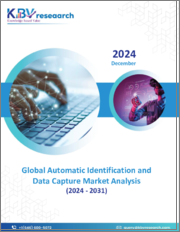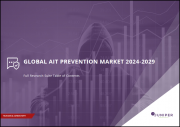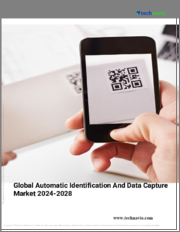
|
시장보고서
상품코드
1371517
세계의 자동 인식 시스템 시장 : 카테고리별, 용도별, 지역별, 기회, 예측(2016-2030년)Automatic Identification System Market Assessment, By Category, By Application, By Region, Opportunities and Forecast, 2016-2030F |
||||||
세계의 자동 인식 시스템 시장 규모는 최근 큰 성장을 달성하고 있으며, 2022년에 약 3억 760만 달러를 기록했습니다. 이 시장은 2023-2030년에 9.4%의 CAGR로 확대하며, 2030년에는 6억 3,110만 달러에 달할 것으로 예측되고 있습니다.
자동 인식 시스템은 실시간 선박 추적 및 충돌 방지를 통해 해상 안전과 효율성을 향상시킬 수 있습니다. 선박의 식별, 위치, 경로 및 속도에 대한 정보를 제공하여 항해를 개선하고 사고 위험을 줄이며 수색 및 구조 활동을 지원하고 혼잡한 수로에서 효과적인 교통 관리를 촉진합니다.
자동인식 시스템 시장은 해상 교통량 증가로 인해 선박 추적 및 충돌 방지 시스템에 대한 필요성이 증가하면서 빠르게 성장하고 있습니다. 엄격한 법률에 따라 안전상의 이유로 선박에 AIS 설치를 의무화하고 있습니다. 또한 기술 개발로 인해 보다 저렴하고 효과적인 AIS 솔루션이 개발되어 다양한 해양 산업에서 활용도가 높아지고 있습니다.
해상 교통량이 증가함에 따라 선박 추적 및 충돌 방지 시스템 개선에 대한 수요가 증가하고 있습니다. 이러한 기술은 해상 교통량이 증가하고 대형 선박이 혼잡한 수로를 항해함에 따라 안전과 효율성을 개선하는 데 필수적인 요소로 자리 잡았습니다. 선박 추적 시스템에는 AIS 기술이 내장되어 있는 경우가 많으며, 선박의 움직임을 실시간으로 모니터링하여 충돌 방지, 교통 관리, 원활한 해상 운항을 지원하고 사고 및 환경 재해의 위험을 줄일 수 있습니다.
세계의 자동 인식 시스템 시장에 대해 조사했으며, 시장의 개요와 카테고리별, 용도별, 지역별 동향 및 시장에 참여하는 기업의 개요 등을 제공하고 있습니다.
목차
제1장 조사 방법
제2장 프로젝트의 범위와 정의
제3장 세계의 자동 인식 시스템 시장에 대한 COVID-19의 영향
제4장 러시아·우크라이나 전쟁의 영향
제5장 주요 요약
제6장 고객의 소리
제7장 세계의 자동 인식 시스템 시장 전망, 2016-2030년
- 시장 규모와 예측
- 카테고리별
- 용도별
- 지역별
- 기업별 시장 점유율(%), 2022년
제8장 세계의 자동 인식 시스템 시장 전망, 지역별, 2016-2030년
- 북미
- 유럽
- 아시아태평양
- 남미
- 중동 및 아프리카
제9장 시장 매핑, 2022년
제10장 거시환경과 산업 구조
- 수요공급 분석
- 공급망 분석
- PESTEL 분석
- Porter's Five Forces 분석
제11장 시장 역학
제12장 주요 참여 기업의 상황
제13장 사례 연구
제14장 주요 기업의 전망
- CNS Systems AB
- Furuno Electric Co.,Ltd.
- Garmin Ltd.
- Japan Radio Co.
- Jotron AS
- Kongsberg Gruppen ASA
- Orbcomm Inc.
- Raymarine(Teledyne FLIR LLC)
- Saab AB
- True Heading AB
제15장 전략적 제안
제16장 문의와 면책사항
KSA 23.11.08Global automatic identification system market has experienced significant growth in recent years and is expected to maintain a strong pace of expansion in the coming years. With projected revenue of approximately USD 307.6 million in 2022, the market is forecasted to reach a value of USD 631.1 million by 2030, displaying a robust CAGR of 9.4% from 2023 to 2030.
The automatic identification system improves maritime safety and efficiency by allowing real-time vessel tracking and collision avoidance. It improves navigation by giving information about vessel identification, position, course, and speed, lowering the danger of accidents, assisting search and rescue operations, and promoting effective traffic management on congested waterways.
The automatic identification system market is expanding rapidly due to growing maritime traffic, raising the need for vessel tracking and collision avoidance systems. Strict laws require the installation of AIS on vessels for safety reasons. Also, technical developments have resulted in more inexpensive and effective AIS solutions, which have increased their usage across diverse nautical industries.
The increased volume of marine traffic has increased demand for improved vessel tracking and collision avoidance systems. These technologies have become critical for improving safety and efficiency as maritime traffic has expanded and larger ships navigate crowded waterways. Vessel tracking systems, which frequently incorporate AIS technology, allow for real-time monitoring of ship movements, assisting in collision prevention, traffic management, and smoother marine operations, lowering the risk of accidents and environmental disasters. Despite the challenges created by global crises such as Ukraine, marine trade is anticipated to expand by 2.4% in 2023. This upward trend is expected to continue, with an annual increase of more than 2% forecast from 2024 through 2028, demonstrating the industry's capacity to overcome significant barriers.
For instance, in October 2022, the Satellite VDES Consortium was formed by IHI Corporation, Furuno Electric, and others to promote marine digital communication using VHF Data Exchange System (VDES) technology, to improve safety and accelerate digital transformation in the ocean industry .
Surge in Maritime Tourism is Fueling the AIS Market
The expansion of maritime tourism, notably in the cruise sector, has aided in adopting Automatic Identification System technology, supporting the AIS market. AIS is progressively integrated into cruise ships to improve passenger safety and overall experience. AIS enables cruise lines to track their ships in real-time, ensuring defined itineraries are followed and accidents with other boats or dangers are avoided. Furthermore, AIS improves onboard safety by allowing faster reaction to emergencies and easing search and rescue operations. As marine tourism is expanding, the need for AIS system will rise, being an essential component of contemporary cruise ship operations.
For example, in November 2021, Japan Radio Co., Ltd. (JRC) partnered with Kawasaki Kisen Kaisha, Ltd. ("K" LINE) and YDK Technologies Co., Ltd. (YDK) for joint research and development of an integrated navigation support system using AI and advanced technology for safer autonomous ship operations.
Need for Search and Rescue Operation
The use of Automatic Identification Systems in search and rescue operations has become a crucial driver of the AIS market's growth. AIS technology provides speedy and precise detection of troubled vessels, allowing authorities to respond quickly to marine crises. When ships emit distress signals or run into problems, AIS data offers essential information on their exact locations, allowing for more targeted rescue attempts. This has raised the effectiveness of SAR operations along with the odds it plays in improving marine safety and security.
For example, in August 2023, The Tron 60AIS, a 406 MHz Satellite Emergency Position Indicating Radio Beacon (EPIRB) for boats, was released by Japan Radio Co., Ltd. (JRC). It automatically transmits distress signals to satellites, allowing for faster rescue responses .
Dominance of Vessel-Based Category in AIS Market
Due to widespread adoption across various maritime sectors, the vessel-based category leads the automatic identification system market. AIS technology makes it essential for ship tracking & safety. Commercial ships, leisure boats, fishing vessels, and smaller craft are required to have vessel-based AIS system. With its widespread acceptance, vessel-based AIS systems will continue to dominate the industry, considering its contribution towards the growth and impact on maritime safety and operations.
North America Dominates Global Automatic Identification System Market
North America's global automatic identification system market dominance is supported by a flourishing marine industry that includes commercial ships, fishing fleets, and recreational boating. Stringent rules mandating the use of AIS have been implemented to protect marine safety and security, which promotes market growth. Leading AIS technology suppliers and manufacturers can be found in North America. The closeness to industry experts stimulates innovation and simplifies access to innovative AIS solutions. The sheer length of North America's coastline, numerous ports, and large marine regions need substantial AIS deployments. Such facilities are essential for vessel monitoring, collision avoidance, and marine surveillance, leading to the dominance of North America in the market.
Government Initiatives Acting as a Catalyst
Governments worldwide understand AIS's critical significance in improving maritime domain awareness (MDA) and security. The Nationwide Automatic Identification System (NAIS) in the United States is a major project. NAIS, which is compliant with the International Maritime Organization's global AIS standard, considerably improves the Coast Guard's ability to monitor boats in the US waterways, ports, and infrastructure. NAIS manages 120 million daily communications at 134 sites across 37 industries, giving critical data to over 80 government systems. Its move to a maintenance phase emphasizes its ongoing role in strengthening maritime security. NAIS enables the United States government to develop effective marine homeland security measures that ensure safety, security, economy, and the environment.
Impact of COVID-19
The COVID-19 pandemic considerably influenced the global market of automatic identification systems. Before the pandemic, the automatic identification system market was steadily growing, driven by increased marine traffic, safety concerns, and regulatory requirements. When the pandemic interrupted global shipping patterns, it created economic uncertainty. The automatic identification system market is experiencing a rebirth in the post-pandemic circumstance. As governments focus on safeguarding their borders and trade networks, the need for vessel tracking and maritime security increased. The marine sector is embracing digital technologies, like AIS, to improve efficiency and safety. These reasons drive the recovery and future growth of the automatic identification system market, with a greater emphasis on resilience and technological integration in marine operations.
Impact of Russia-Ukraine War
The Russia-Ukraine war had a noticeable influence on the automatic identification system market. With increased tensions in the Black Sea & surrounding waterways, there has been a noticeable increase in maritime actions, including military activities and trade route diversions. It boosted the demand for improved AIS equipment to monitor vessel movements, improve maritime security, and assure safe navigation. As a result, the governments and maritime authorities have increased their spending on AIS infrastructure and solutions. For example, Ukraine strengthened its naval surveillance capabilities, while NATO partners increased AIS deployments in the region. These trends highlight a clear relationship between geopolitical events and the expansion of the automatic identification system market.
Key Players Landscape and Outlook
Key global automatic identification system market companies include: Saab AB, Furuno Electric Co. Ltd., Garmin Ltd., Raymarine, and Orbcomm Inc. Through innovative technology and enormous market reach, these industrial titans have solidified their positions. The automatic identification system market has great development potential, owing to the increasing use of AIS for marine safety and navigation. The growth in marine commerce, stringent regulatory requirements, and the need for real-time vessel surveillance are key market influences. These companies are set to continue influencing the AIS environment and its future by committing to innovation and strategic collaborations.
In January 2022, Garmin purchased Vesper Maritime, which provides maritime communication solutions such as AIS and VHF technologies. This purchase expands Garmin's maritime product offering, providing boaters with improved situational awareness .
Table of Contents
1. Research Methodology
2. Project Scope & Definitions
3. Impact of COVID-19 on the Global Automatic Identification System Market
4. Impact of Russia-Ukraine War
5. Executive Summary
6. Voice of Customer
- 6.1. Product and Market Intelligence
- 6.2. Mode of Brand Awareness
- 6.3. Factors Considered in Purchase Decisions
- 6.3.1. Features and other value-added service
- 6.3.2. IT Infrastructure Compatibility
- 6.3.3. Efficiency of Solutions
- 6.3.4. After-Sales Support
- 6.4. Consideration of Privacy & Safety Regulations
7. Global Automatic Identification System Market Outlook, 2016-2030F
- 7.1. Market Size & Forecast
- 7.1.1. By Value
- 7.1.2. By Volume
- 7.2. By Category
- 7.2.1. Vessel-Based
- 7.2.1.1. Class A
- 7.2.1.2. Class B
- 7.2.2. Terrestrial-Based
- 7.2.3. Satellite-Based
- 7.2.1. Vessel-Based
- 7.3. By Application
- 7.3.1. Coastal Monitoring & Traffic Coordination
- 7.3.2. Airborne Tracking
- 7.3.3. Offshore Tracking
- 7.3.4. AtoN Monitoring
- 7.4. By Region
- 7.4.1. North America
- 7.4.2. Europe
- 7.4.3. Asia-Pacific
- 7.4.4. South America
- 7.4.5. Middle East and Africa
- 7.5. By Company Market Share (%), 2022
8. Global Automatic Identification System Market Outlook, By Region, 2016-2030F
- 8.1. North America*
- 8.1.1. Market Size & Forecast
- 8.1.1.1. By Value
- 8.1.1.2. By Volume
- 8.1.2. By Category
- 8.1.2.1. Vessel-Based
- 8.1.2.1.1. Class A
- 8.1.2.1.2. Class B
- 8.1.2.2. Terrestrial-Based
- 8.1.2.3. Satellite-Based
- 8.1.3. By Application
- 8.1.3.1. Coastal Monitoring & Traffic Coordination
- 8.1.3.2. Airborne Tracking
- 8.1.3.3. Offshore Tracking
- 8.1.3.4. AtoN Monitoring
- 8.1.4. United States*
- 8.1.4.1. Market Size & Forecast
- 8.1.4.1.1. By Value
- 8.1.4.1.2. By Volume
- 8.1.4.2. By Category
- 8.1.4.2.1. Vessel-Based
- 8.1.4.2.1.1. Class A
- 8.1.4.2.1.2. Class B
- 8.1.4.2.2. Terrestrial-Based
- 8.1.4.2.3. Satellite-Based
- 8.1.4.3. By Application
- 8.1.4.3.1. Coastal Monitoring & Traffic Coordination
- 8.1.4.3.2. Airborne Tracking
- 8.1.4.3.3. Offshore Tracking
- 8.1.4.3.4. AtoN Monitoring
- 8.1.5. Canada
- 8.1.6. Mexico
- 8.1.1. Market Size & Forecast
All segments will be provided for all regions and countries covered:
- 8.2. Europe
- 8.2.1. Germany
- 8.2.2. France
- 8.2.3. Italy
- 8.2.4. United Kingdom
- 8.2.5. Russia
- 8.2.6. Netherlands
- 8.2.7. Spain
- 8.2.8. Turkey
- 8.2.9. Poland
- 8.3. Asia-Pacific
- 8.3.1. India
- 8.3.2. China
- 8.3.3. Japan
- 8.3.4. Australia
- 8.3.5. Vietnam
- 8.3.6. South Korea
- 8.3.7. Indonesia
- 8.3.8. Philippines
- 8.4. South America
- 8.4.1. Brazil
- 8.4.2. Argentina
- 8.5. Middle East & Africa
- 8.5.1. Saudi Arabia
- 8.5.2. UAE
- 8.5.3. South Africa
9. Market Mapping, 2022
- 9.1. By Category
- 9.2. By Application
- 9.3. By Region
10. Macro Environment and Industry Structure
- 10.1. Demand Supply Analysis
- 10.2. Supply Chain Analysis
- 10.3. PESTEL Analysis
- 10.3.1. Political Factors
- 10.3.2. Economic System
- 10.3.3. Social Implications
- 10.3.4. Technological Advancements
- 10.3.5. Environmental Impacts
- 10.3.6. Legal Compliances and Regulatory Policies (Statutory Bodies Included)
- 10.4. Porter's Five Forces Analysis
- 10.4.1. Supplier Power
- 10.4.2. Buyer Power
- 10.4.3. Substitution Threat
- 10.4.4. Threat from New Entrant
- 10.4.5. Competitive Rivalry
11. Market Dynamics
- 11.1. Growth Drivers
- 11.2. Growth Inhibitors (Challenges and Restraints)
12. Key Players Landscape
- 12.1. Competition Matrix of Top Five Market Leaders
- 12.2. Market Revenue Analysis of Top Five Market Leaders (in %, 2022)
- 12.3. Mergers and Acquisitions/Joint Ventures (If Applicable)
- 12.4. SWOT Analysis (For Five Market Players)
- 12.5. Patent Analysis (If Applicable)
13. Case Studies
14. Key Players Outlook
- 14.1. CNS Systems AB
- 14.1.1. Company Details
- 14.1.2. Key Management Personnel
- 14.1.3. Products & Services
- 14.1.4. Financials (As reported)
- 14.1.5. Key Market Focus & Geographical Presence
- 14.1.6. Recent Developments
- 14.2. Furuno Electric Co.,Ltd.
- 14.3. Garmin Ltd.
- 14.4. Japan Radio Co.
- 14.5. Jotron AS
- 14.6. Kongsberg Gruppen ASA
- 14.7. Orbcomm Inc.
- 14.8. Raymarine (Teledyne FLIR LLC)
- 14.9. Saab AB
- 14.10. True Heading AB
Companies mentioned above DO NOT hold any order as per market share and can be changed as per information available during research work.



















